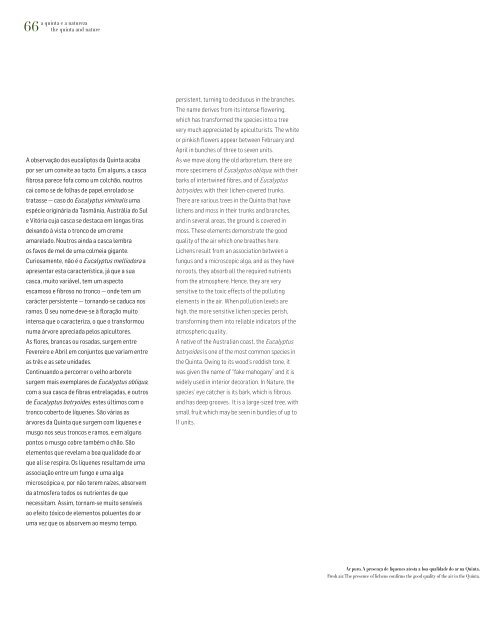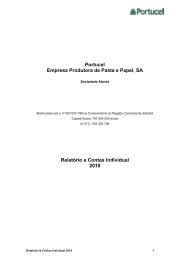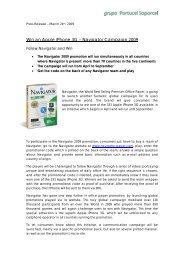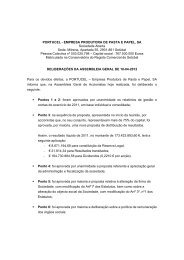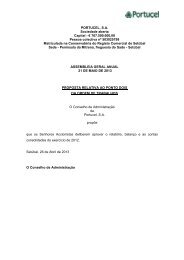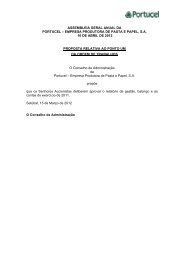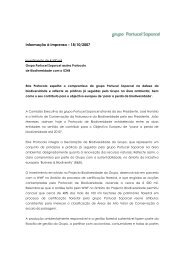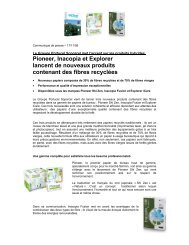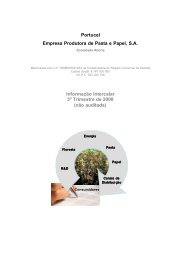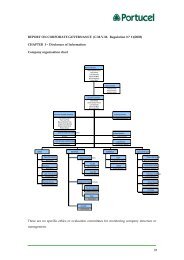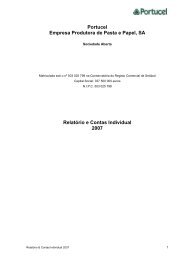Os Eucaliptos e as Aves da Quinta de São Francisco
Os Eucaliptos e as Aves da Quinta de São Francisco
Os Eucaliptos e as Aves da Quinta de São Francisco
You also want an ePaper? Increase the reach of your titles
YUMPU automatically turns print PDFs into web optimized ePapers that Google loves.
a quinta e a natureza<br />
66 the quinta and nature<br />
A observação dos eucaliptos <strong>da</strong> <strong>Quinta</strong> acaba<br />
por ser um convite ao tacto. Em alguns, a c<strong>as</strong>ca<br />
fibrosa parece fofa como um colchão, noutros<br />
cai como se <strong>de</strong> folh<strong>as</strong> <strong>de</strong> papel enrolado se<br />
trat<strong>as</strong>se — c<strong>as</strong>o do Eucalyptus viminalis uma<br />
espécie originária <strong>da</strong> T<strong>as</strong>mânia, Austrália do Sul<br />
e Vitória cuja c<strong>as</strong>ca se <strong>de</strong>staca em long<strong>as</strong> tir<strong>as</strong><br />
<strong>de</strong>ixando à vista o tronco <strong>de</strong> um creme<br />
amarelado. Noutros ain<strong>da</strong> a c<strong>as</strong>ca lembra<br />
os favos <strong>de</strong> mel <strong>de</strong> uma colmeia gigante.<br />
Curiosamente, não é o Eucalyptus melliodora a<br />
apresentar esta característica, já que a sua<br />
c<strong>as</strong>ca, muito variável, tem um <strong>as</strong>pecto<br />
escamoso e fibroso no tronco — on<strong>de</strong> tem um<br />
carácter persistente — tornando-se caduca nos<br />
ramos. O seu nome <strong>de</strong>ve-se à floração muito<br />
intensa que o caracteriza, o que o transformou<br />
numa árvore aprecia<strong>da</strong> pelos apicultores.<br />
As flores, branc<strong>as</strong> ou rosad<strong>as</strong>, surgem entre<br />
Fevereiro e Abril em conjuntos que variam entre<br />
<strong>as</strong> três e <strong>as</strong> sete uni<strong>da</strong><strong>de</strong>s.<br />
Continuando a percorrer o velho arboreto<br />
surgem mais exemplares <strong>de</strong> Eucalyptus obliqua,<br />
com a sua c<strong>as</strong>ca <strong>de</strong> fibr<strong>as</strong> entrelaçad<strong>as</strong>, e outros<br />
<strong>de</strong> Eucalyptus botryoi<strong>de</strong>s, estes últimos com o<br />
tronco coberto <strong>de</strong> líquenes. <strong>São</strong> vári<strong>as</strong> <strong>as</strong><br />
árvores <strong>da</strong> <strong>Quinta</strong> que surgem com líquenes e<br />
musgo nos seus troncos e ramos, e em alguns<br />
pontos o musgo cobre também o chão. <strong>São</strong><br />
elementos que revelam a boa quali<strong>da</strong><strong>de</strong> do ar<br />
que ali se respira. <strong>Os</strong> líquenes resultam <strong>de</strong> uma<br />
<strong>as</strong>sociação entre um fungo e uma alga<br />
microscópica e, por não terem raízes, absorvem<br />
<strong>da</strong> atmosfera todos os nutrientes <strong>de</strong> que<br />
necessitam. Assim, tornam-se muito sensíveis<br />
ao efeito tóxico <strong>de</strong> elementos poluentes do ar<br />
uma vez que os absorvem ao mesmo tempo.<br />
persistent, turning to <strong>de</strong>ciduous in the branches.<br />
The name <strong>de</strong>rives from its intense flowering,<br />
which h<strong>as</strong> transformed the species into a tree<br />
very much appreciated by apiculturists. The white<br />
or pinkish flowers appear between February and<br />
April in bunches of three to seven units.<br />
As we move along the old arboretum, there are<br />
more specimens of Eucalyptus obliqua, with their<br />
barks of intertwined fibres, and of Eucalyptus<br />
botryoi<strong>de</strong>s, with their lichen-covered trunks.<br />
There are various trees in the <strong>Quinta</strong> that have<br />
lichens and moss in their trunks and branches,<br />
and in several are<strong>as</strong>, the ground is covered in<br />
moss. These elements <strong>de</strong>monstrate the good<br />
quality of the air which one breathes here.<br />
Lichens result from an <strong>as</strong>sociation between a<br />
fungus and a microscopic alga, and <strong>as</strong> they have<br />
no roots, they absorb all the required nutrients<br />
from the atmosphere. Hence, they are very<br />
sensitive to the toxic effects of the polluting<br />
elements in the air. When pollution levels are<br />
high, the more sensitive lichen species perish,<br />
transforming them into reliable indicators of the<br />
atmospheric quality.<br />
A native of the Australian co<strong>as</strong>t, the Eucalyptus<br />
botryoi<strong>de</strong>s is one of the most common species in<br />
the <strong>Quinta</strong>. Owing to its wood’s reddish tone, it<br />
w<strong>as</strong> given the name of “fake mahogany” and it is<br />
wi<strong>de</strong>ly used in interior <strong>de</strong>coration. In Nature, the<br />
species’ eye catcher is its bark, which is fibrous<br />
and h<strong>as</strong> <strong>de</strong>ep grooves. It is a large-sized tree, with<br />
small fruit which may be seen in bundles of up to<br />
11 units.<br />
Ar puro. A presença <strong>de</strong> líquenes atesta a boa quali<strong>da</strong><strong>de</strong> do ar na <strong>Quinta</strong>.<br />
Fresh air. The presence of lichens confirms the good quality of the air in the <strong>Quinta</strong>.


